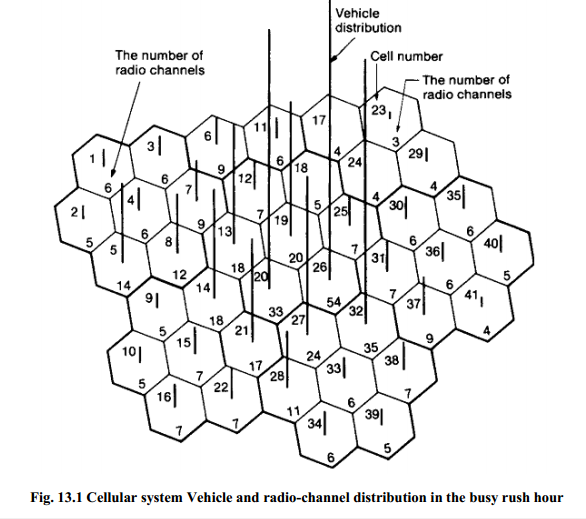Compare the average blocking in spatially uniform and non uniform traffic distribution for FCA, BCA and FBCA.
13. Compare the average blocking in spatially uniform and non uniform traffic distribution for FCA, BCA and FBCA.
On the basis of the FBCA, FCA, and BCA algorithms, a seven-cell reuse pattern with an average blocking of 3 percent is assumed and the total traffic service in an area in 250 Erlangs. The traffic distributions are
(1) Uniform traffic distribution—11 channels per cell;
(2) A non uniform traffic distribution—the number of channels in each cell is dependent on the vehicle distribution (Fig.13.1).
The simulation model is described as follows:
1. Randomly select the cell (among 41 cells).
2. Determine the state of the vehicle in the cell (idle, off-hook, on-hook, and handoff)
3. In off-hook or handoff state, search for an idle channel. The average number of handoffs is assumed to be 0.2 times per call. However, FBCA will increase the number of handoffs.
Average Blocking: Two average blocking cases illustrating this simulation are shown in Fig. 13.2. In a uniform traffic condition (Fig. 13.2a), the 3 percent blocking of both BCA and FBCA will result in a load increase of 28 percent, compared to 3 percent blocking of FCA. There is no difference between BCA and FBCA when a uniform traffic condition exists.
In a non uniform traffic distribution (Fig. 13.2b), the load increase in BCA drops to 23 percent and that of FBCA increases to 33 percent, as at an average blocking of 3 percent. The load increase can be utilized in another way by reducing the number of channels. The percent increase in load is the same as the percent reduction in the number of channels.
Handoff Blocking: Blocking calls from all handoff calls occurring in all cells is shown in Fig. 13.3. Handoff blocking is not considered as the regular cell blocking which can only occur at the call setup stage. In both BCA and FBCA, load is increased almost equally to 30 percent, as compared to FCA at 3 percent handoff blocking in uniform traffic (Fig. 13.3a). For a non uniform traffic distribution, the load increase of both BCA and FBCA at 4 percent blocking is about 50 percent (Fig. 13.3b), which is a big improvement, considering the reduction in interference and blocking. Otherwise, there would be multiple effects from interference in several neighbouring cells.



%20Average.PNG)
%20Handoff.PNG)
